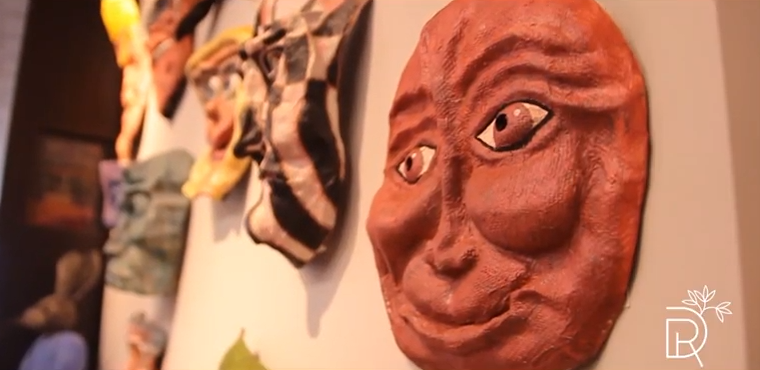
The Pollination Station is made up of both native perennials and non-native annuals. The requirements to be included were that the plants had to be happy in a container, support our native pollinating insects – and be blooming at this time of year.
There are many, many more plants available for a pollinator garden – or pollination station – that will offer different blooms throughout the seasons.
For an excellent resource on Pollinator Gardens, check out “ A Garden for the Rusty Patched Bumble Bee – Creating Habitat for Native Pollinators” by Lorraine Johnson and Sheila Colla. Published by Douglas and MacIntyre.
Grey Gallery is a small independent commercial art gallery with adjoining outdoor space, which includes a small community garden, sculpture, perennial plantings, and seating. It is open to the public during gallery hours and the space also hosts concerts and other community events.
We are trained volunteers who offer non-biased, science-based horticultural information and advice to home gardeners and community groups. Established in 1996, the Grey County Master Gardeners are a member group of Master Gardeners of Ontario Inc. (MGOI).
To help cover the costs of our community services, we request donations for our presentations. To make a donation to Grey County Master Gardeners, please contact us at greycountymg@gmail.com.
The Williamsford Landscape Co. offers landscape design, garden makeovers, tree and plant recommendations.
Willow Farm Grasses, (Downtown Bognor, 597326, Grey Rd 29, Meaford, ON N0H 1E0), is a nursery specializing in hardy ornamental grasses and native plants. In business since 2010, our selection has grown to include hundreds of pollinator and bird-friendly plants. Come tour the gardens, walk the trails, and enjoy the wildlife!
Here is a list of the Native Plants, including a few of the non-native Annuals
Hairy Beardtongue (Penstemon hirsutus)
Hairy Beardtongue is a perfect addition to a pollinator garden. This perennial is native to North America, grows 18″ tall in full sun and well drained soil, but tolerates some shade. Beginning in late spring, its purple-white trumpet-shaped flowers bloom for up to six weeks and pollinate a number of bees, including sweat bees, leafcutter bees, and newly hatched bumble bees. It is also a larval host for the Baltimore Checkerspot butterfly.
Foxglove Beardtongue (Penstemon digitalis)
Very similar to its Hairy cousin, the tall Foxglove Beardtongue is an elegant white bloom, with the same requirements and pollinator benefits. It can grow up to 5 feet tall.
Golden Ragwort (Packera aurea)
Also called golden groundsel, this native perennial is valued for its ability to thrive in moist shady locations, naturalize rapidly and produce a long and profuse spring bloom. It features flat-topped clusters (corymbs) of yellow, daisy-like flowers (to 1" diameter) atop sparsely-leaved stems in early spring.
Zizia is an important early source of pollen and nectar for newly emerging bees and other insects, including mining bees, azure butterflies and soldier beetles. It also serves as a larval host plant for the black swallowtail butterfly.
Walkers Low Catmint(Nepeta faassenii)
Walker's Low' Catmint is known for its easy going nature - it can thrive in a variety of soils and light conditions, though it does best on the sunny, dry side. Beautiful purple flower spikes appear in early summer and continue to bloom and release their sweet fragrance for up to 3 months. Although not native, Walkers Low is a pollinator magnet for many bees and butterflies. Deer resistant.
Eastern Red Columbine (Aquilegia canadensis)
The nodding red and yellow flowers of our native columbine provide a critical food source for returning ruby-throated hummingbirds in spring. They are also visited by bumblebees and hawk moths for the nectar, and other bees for the pollen. The blossoms are held on sturdy stems above the foliage, forming a cloud of blossoms on larger plants. It prefers loamy soil, dry to medium moisture and sun to part shade.
Bicknell's Sedge (Carex bicknellii)
A versatile native sedge, that grows in both dry upland prairies and wet river bottom prairies. It is more tolerant of dry soil than other sedges and will grow in full sun to partial shade. The flowering heads grow up to 3 ft. high, much higher than the narrow grass-like leaves of the foliage. The seedheads are not as showy as some of the other sedges, but birds still love them.
Woodland Sage(Salvia nemorosa)
Though not native, Woodland sage is a welcome addition to a pollinator garden. The closely spaced whorls of small purple flowers contain a trigger mechanism that deposits pollen on the back side of visiting bees. This pollen then becomes transferred to female Salvia flowers that share the same receptive flower parts encouraging pollination among the same or similar species. Low maintenance, it needs full sun and rich soil for best flowering, and rich soil. Once established in the garden, Salvia is quite drought tolerant.
Pearly everlasting (Anaphalis margaritacea)
Drought and salt tolerant, this Ontario native perennial tolerates poor soil conditions and typically grows on dry, sandy or gravelly sites. While it prefers full sun, it tolerates part-shade. It has woolly, silver-gray foliage and a shorter growth habit that makes a nice garden edge or for use in front of taller plants and very showy pearly-white and yellow blooms that appear in late summer, when fewer plants are in flower for pollinators.
Pearly everlasting is an important food source for caterpillars of both the American lady and painted lady butterflies.
Golden Alexander (Zizia aurea)
This is a native Ontario perennial with flat-topped clusters (umbels) of tiny yellow flowers in late spring, on top of 3 foot stems. Much loved by butterflies, it is a host plant for the black swallowtail butterfly and an important source of pollen for bees.
Black Chokeberry (Aronia melanocarpa)
Black Chokeberry is a medium sized shrub, native to the eastern half of North America including Ontario. It is covered in white blooms for a few weeks in mid to late spring. On closer inspection, the flower is all the more spectacular because of its many hot pink stamens. At the end of the summer, distinctive dark berries appear. Then, in the fall, the leaves turn a vibrant red.
The black chokeberry has a high wildlife value and will bring plenty of interest to anyone who wants to observe spring bees in action.



